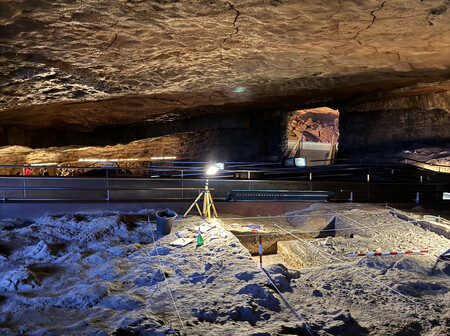A few minutes by car from the beautiful, cool and walkable Cantabrian town of Santillana del Mar is one of the great national treasures, the Altamira Cave. Closed to the public now for obvious reasons, but visitable through a recreation made to the millimeter called NeocaveAltamira preserves an impressive collection of Palaeolithic paintings, the oldest with more than 30,000 years of history. And like many other great discoveries, we came across it by chance. This is its story.
Modesto Cubillas. Although the discovery of the Altamira Cave has always been surrounded by some controversy, the Spanish Ministry of Culture It is attributed to him to Modesto Cubillas in 1868. The story goes that Cubillas was hunting when his dog fell over some rocks while chasing prey. When he came to its aid, he came across the caves, which he did not give much importance to because 1) they were common in the region and 2) they were covered with vegetation.
The first visitCubillas told his neighbours what he had seen, but that was all. It was not until 1875 when Marcelino Sanz de Sautuola, a Spanish naturalist, prehistorian and great-great-grandfather of Ana Botín (President of the Board of Directors of Banco Santander), visited the cave for the first time and found no things that caught his attention, apart from a few black lines that he did not attach any importance to.

Entrance to the Neocave that recreates the original entrance | Image: Xataka
But what if… Years later, Marcelino attended the World’s Fair in Paris in 1878 and there he could see prehistoric objects. What they looked like, how to identify them. Armed with new knowledge, he decided to return to the cave with the little girl Maria San de Sautuola and Galanteher daughter who was only eight years old. That was in the year 1879.
Innocent curiosityWhile her father searched for remains at the entrance to the cave, little Maria, motivated by the innate curiosity of a child of her age, decided to continue forward and enter the gallery. When she reached the bottom, Maria shouted “Look, daddy, oxen” while pointing to the ceiling. They were not oxen, but bison, but the mistake was normal: oxen were the draft animals used in the area.
Marcellinus identified the species depicted as the bison, which was then considered extinct in Europe, but he found no bones of the animal in the cave. Given the unusual nature of the cave, whose realistic paintings extended across the entire ceiling, making it one of the most important and largest discoveries of the time, all kinds of debates arose. From denial of the discovery to accusations that it was Marcellinus himself who had painted the figures. However, the years would prove him right, although rivers and rivers of ink could be written about this.


They weren’t oxen, they were bison | Image: Xataka
And it got messy. The news of the discovery of the paintings soon spread to the surrounding areas. Hundreds and hundreds of people came to the cave carrying, in a complete act of irresponsibility resulting from ignorance, candles, lanterns, compasses and ropes. Visitors took the remains home, dug up the ground to find more and the cave began to deteriorate.
So Marcelino Sanz de Sautuloa decided to put a wooden door in the hole that served as an entrance. He paid for this door out of his own pocket and after obtaining permission from the village of Vispieres, owners of the cave. In exchange, he invited them to a picnic that took place, curiously, inside Altamira. In the image below you can see the signed document and the promise to have a picnic. Later, in 1880, the wooden door was replaced by an iron gate and a guard was appointed.


Authorization signed by the neighbors to put a wooden door at the entrance of the cave | Image: Xataka
The entry is not the originalAn important note: the hole that was covered with a grate was not the original entrance. The large mouth of the cave where the inhabitants of Altamira lived collapsed 13,000 years ago. That entrance remained covered until its discovery in 1869. Thanks to the stability of the atmosphere inside, the paintings have been able to be so well preserved for millennia. The current entrance was built in 1927 and the closest thing to the original mouth is the entrance to the Neocave.
The problem of visits. Returning to the cave, in 1910 the Santillana del Mar City Council created a Committee for the Conservation and Defense of the Cave that, back in 1917, allowed guided visits. In 1924 it was declared a National Monument and the rest can be imagined. The number of people who accessed the cave increased more and more, with the 60s and 70s being the most dangerous decades. In 1973 alone, more than 174,000 people entered the interior. Such was the influx of people that, after a study and a debate that reached the Congress of Deputiesit was closed in 1977.


Panoramic view of the ceiling of the Altamira Cave | Image: Xataka
Altamira was closed until 1982, when it reopened with a limited capacity of 8,500 people per year. The interest of the people gave rise to the idea of creating a replica that could be visited, something that happened in 2001 with the Neocave located in the recently opened Altamira National Museum and Research Centre. In 2002, the cave was closed to the public again. awaiting impact studiesIt would reopen in February 2014 and remain open until August of that same year, admitting five people per day for 37 minutes to study the impact of possible visits.
Currently, the Altamira cave has a controlled access regime and very limited public visits. This access regime, approved by the Museum’s Board of Trustees, establishes a maximum of five people per week, 260 people per year. There is a waiting list, closed since 2002, which was reactivated in 2020 and whose registered users will be able to visit the original cave when their turn comes.
Getting to know AltamiraAnd now that we know the story, and given that knowledge takes up no space, we will now teach you how to identify all the figures in Altamira so that, if one day you have the opportunity to visit it, you will know what you are looking at.


The sign. It is not known what it means, but it dates back 36,000 years | Image: Xataka


The hand. 22,000 years old | Image: Xataka


The rampant horse. 22,000 years old | Image: Xataka


The goat. It is a Pyrenean goat (you can tell by its horns). 18,000 years old | Image: Xataka


Standing bison. 18,500 years old | Image: Xataka


The doe. It is curious, because the belly is on a natural bulge of the rock, which could indicate that the doe was pregnant. 18,500 years old | Image: Xataka


Bison head. 18,500 years old | Image: Xataka


Bison lying down. It’s curious, because they took advantage of the natural reliefs of the rock to give depth to the painting. 18,500 years old | Image: Xataka


The masks. Black strokes on the edges of the rock that simulate faces | Image: Xataka
Images | Xataka
At Xataka | We have been discussing the origin of writing for years. Now an Asturian cave can settle the debate



![[Img #74675]](https://thelatestnews.world/wp-content/uploads/2024/12/They-discover-a-new-class-of-X-ray-sources-in-the-150x150.jpg)









![[Img #74675]](https://thelatestnews.world/wp-content/uploads/2024/12/They-discover-a-new-class-of-X-ray-sources-in-the-300x200.jpg)


Add Comment